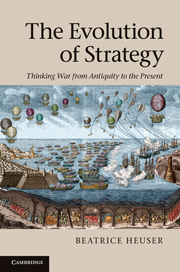Book contents
- Frontmatter
- Contents
- Acknowledgements
- A note on referencing
- Part I Introduction
- PART II Long-term constants
- PART III The Napoleonic paradigm and Total War
- 5 The age and mindset of the Napoleonic paradigm
- 6 The Napoleonic paradigm transformed: From total mobilisation to Total War
- 7 Challenges to the Napoleonic paradigm versus the culmination of Total War
- PART IV Naval and maritime Strategy
- PART V Air Power and nuclear Strategy
- PART VI Asymmetric or ‘small’ wars
- PART VII The quest for new paradigms after the World Wars
- Bibliography
- Index
6 - The Napoleonic paradigm transformed: From total mobilisation to Total War
from PART III - The Napoleonic paradigm and Total War
Published online by Cambridge University Press: 05 June 2012
- Frontmatter
- Contents
- Acknowledgements
- A note on referencing
- Part I Introduction
- PART II Long-term constants
- PART III The Napoleonic paradigm and Total War
- 5 The age and mindset of the Napoleonic paradigm
- 6 The Napoleonic paradigm transformed: From total mobilisation to Total War
- 7 Challenges to the Napoleonic paradigm versus the culmination of Total War
- PART IV Naval and maritime Strategy
- PART V Air Power and nuclear Strategy
- PART VI Asymmetric or ‘small’ wars
- PART VII The quest for new paradigms after the World Wars
- Bibliography
- Index
Summary
[T]he absolute form of war is deduced, not from any of the changes in weapons or in the organizations of armies, but from the entrance of nations into the arena which was before occupied by ‘sovereigns and statesmen’.
(Henry Spenser Wilkinson 1910: 181)This chapter will examine the predominating elements of Strategy in the long nineteenth century and map the evolution of the Napoleonic paradigm into one of Total War along two strands. The first was rooted in the perceived need to make warfare – defensive warfare – more effective by harnessing the entire nation’s strength to the cause of the defence of the country, including all its members, all its productivity, all its wealth. In truth this was more an ideal of the French Revolution than a Napoleonic measure, but the two were often merged into one in the minds of men. This ideal originated even before the Revolution, in the Enlightenment, with Count Guibert. It is what would in the First World War be called ‘total war’ in the sense of ‘total mobilisation of one’s national resources’ by the French politician Léon Daudet, who claimed to have invented the term (Daudet 1918: 8f.).
The second is the quest for a war-deciding battle, which is truly the core of the Napoleonic paradigm. Clausewitz saw the ‘battle of annihilation’ as central to Napoleon’s success (Clausewitz 1832/1976, IV: 11). The sense of the term ‘annihilation’ would evolve over time in a terrible way, under the shadow of Social Darwinism and racism, as we shall see.
- Type
- Chapter
- Information
- The Evolution of StrategyThinking War from Antiquity to the Present, pp. 137 - 170Publisher: Cambridge University PressPrint publication year: 2010



